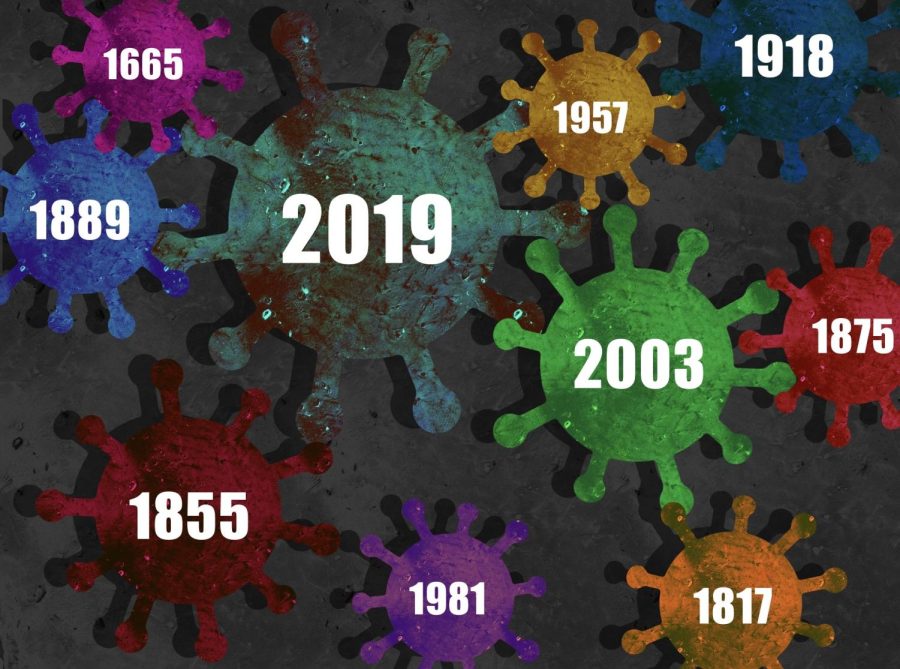The last ten pandemics in history each changed our world
Humans have managed to progress through generations despite previous pandemics
2021 marks the second year in the current COVID-19 pandemic.
Starting in 2020, we experienced COVID-19, which transformed our lives — the way we lived day to day and how we socialized. For everyone’s safety, we needed to start wearing face masks and keeping a social distance.
1665: The Great Plague of London
The Bubonic plague is a disease that is mostly transmitted to people by infected fleas that travel on rodents. Known as the Black Death, it was responsible for the deaths of millions of Europeans throughout the Middle Ages. Prevention does not entail vaccination, but it does include limiting your exposure to infected mice, rats, squirrels, and other animals.
1817: First Cholera Pandemic
The first cholera pandemic in India occurred in the Bengal area, near Calcutta (now Kolkata), from 1817 to 1824. Cholera is a contagious disease caused by the bacteria Vibrio cholerae. The bacteria often resides in somewhat saline and warm environments, such as estuaries and coastal seas.
1855: The Third Plague Pandemic
Bubonic plague is a severe illness with a high fatality rate that is spread primarily through the bite of a rat flea or through person-to-person transmission when in its pneumonic stage. Few are aware that Europe was also affected by the plague during the third plague pandemic, which began in 1894 when it spread from Hong Kong to the rest of the world, including Europe.
1875: Fiji Measles Epidemic
After Fiji was lost to the British Empire, Queen Victoria sent a royal party to Australia as a gift. The royal group carried the sickness back to their island amid a measles outbreak, and it was transmitted further by the tribe leaders and police who met with them upon their return. Measles spread in Fiji from February to June in 1875, killing an estimated one-fifth to one-fourth of the general population.
1889: Russian Flu
Scientists observed that this flu tended to follow major highways, waterways, and most importantly— railway lines, many of which did not exist during the previous large outbreak in the 1840s. This discovery confirmed the hypothesis that the illness was carried by human contact rather than the wind or other ways, and that preventing its spread would be practically impossible as long as people could freely roam from city to city and country to country.
1918: Spanish Flu
The 1918 influenza pandemic was the worst in modern history. It was caused by an H1N1 virus containing avian genes. Although there is no universal agreement on where the virus originated, it spread throughout the world during 1918-1919.
1957: Asian flu
The “Asian Flu” was a category two avian influenza pandemic that began in China in early 1956 and lasted until 1958. It arose as a result of a mutation in wild ducks merging with an already existing human strain. In 1957, an H2N2 vaccination was released, and the pandemic was delayed.
1981: HIV/AIDS
The virus that causes HIV infection is called the human immunodeficiency virus (HIV). The most advanced stage of HIV infection is acquired immunodeficiency syndrome (AIDS). HIV is transmitted by contact with an HIV-positive person’s blood, sperm, pre-seminal fluid, rectal fluids, vaginal fluids, or breast milk. In the United States, HIV is mostly transmitted through intercourse or by sharing injectable drug equipment with an HIV-positive individual.
2003: SARS
SARS (severe acute respiratory syndrome) is a viral respiratory infection caused by a coronavirus known as SARS-associated coronavirus (SARS-CoV). In February 2003, the first cases of SARS were reported in Asia. Before the 2003 SARS worldwide pandemic was halted, the sickness expanded to more than two dozen nations in North America, South America, Europe, and Asia during the following few months.
2019: COVID-19
COVID-19 is a coronavirus disease caused by SARS-CoV-2, which first emerged in December 2019. COVID-19 can be fatal, causing millions of fatalities worldwide as well as long-term health consequences in those who survive the sickness. The coronavirus is contagious and can be passed from person to person. A laboratory test is used to diagnose it.
Your donation will support the student journalists of Mead High School. Your contribution will allow us to purchase equipment and cover our annual website hosting costs.

Ana Carrillo is a Senior. She enjoys hanging out with friends, outdoor activities and random adventures. She is on the tennis team this year. She is looking forward to communicating current events occurring in and outside of school.

Kaylyn is a senior. She enjoys reading, playing video games, and driving. Outside of school she likes to sing loudly on her way to work. She is excited to write articles that students can relate to.












Natalie Yoder • Mar 18, 2022 at 9:21 am
This is so interesting! I love this, it’s so relevant